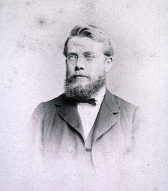The next year Dubois's workers found a virtually complete thighbone that looked surprisingly modern. In fact, many anthropologists think itis modern, and has nothing to do with Java Man. If it is an erectus bone, it is unlike any other found since. Nonetheless Dubois used the thighbone to deduce—correctly, as it turned out—that Pithecanthropus walked upright. He also produced, with nothing but a scrap of cranium and one tooth, a model of the complete skull, which also proved uncannily accurate.[qh]
第二年,杜布瓦的工人們發(fā)現(xiàn)了一根幾乎完整的大腿骨,令人吃驚的是,這塊骨頭看上去與現(xiàn)代人的特點(diǎn)十分相似。事實(shí)上,許多人類學(xué)家認(rèn)為他就是現(xiàn)代人,與爪哇人沒(méi)有任何關(guān)系。即使是一根直立人的骨頭,它也與已經(jīng)發(fā)現(xiàn)的其他化石不同。杜布瓦據(jù)此推論——后來(lái)證明是正確的——類人猿是直立行走的。僅僅根據(jù)一小塊頭蓋骨和一顆牙齒,杜布瓦還竟然制作成了一個(gè)完整的頭骨模型,而且后來(lái)證明,他的制作也縣非常精確。[qh]

古斯塔夫·施瓦爾布
In 1895, Dubois returned to Europe, expecting a triumphal reception. In fact, he met nearly the opposite reaction. Most scientists disliked both his conclusions and the arrogant manner in which he presented them. The skullcap, they said, was that of an ape, probably a gibbon, and not of any early human. Hoping to bolster his case, in 1897 Dubois allowed a respected anatomist from the University of Strasbourg, Gustav Schwalbe, to make a cast of the skullcap. To Dubois's dismay, Schwalbe thereupon produced a monograph that received far more sympathetic attention than anything Dubois had written and followed with a lecture tour in which he was celebrated nearly as warmly as if he had dug up the skull himself. Appalled and embittered, Dubois withdrew into an undistinguished position as a professor of geology at the University of Amsterdam and for the next two decades refused to let anyone examine his precious fossils again. He died in 1940 an unhappy man.[qh]
1895年,杜布瓦回到歐洲,希望贏得一片喝彩聲。實(shí)際上他遇到的反應(yīng)幾乎恰恰相反。大多數(shù)科學(xué)家既不贊同他的結(jié)論,也不喜歡他擺出的那副傲慢無(wú)禮的態(tài)度。他們認(rèn)為,那塊頭蓋骨是猿猴的,很可能是長(zhǎng)臂猿的,根本不是什么早期人類的。他于1897年請(qǐng)斯特拉斯堡大學(xué)一位有名望的解剖學(xué)家古斯塔夫·施瓦爾布制作了一個(gè)頭盞骨模型。希望支持自己的觀點(diǎn)。施瓦爾布據(jù)此寫了一篇論文,令杜布瓦大吃一驚的是,這篇論文所受到的支持和關(guān)注程度遠(yuǎn)遠(yuǎn)超過(guò)了杜布瓦所寫的任何東西。接著,施瓦爾布還作了一系列巡回演講,受到熱烈的贊賞,好像那塊化石是他挖到的。杜布瓦既驚又恨,之后他接受了一個(gè)平凡的職位,在阿姆斯特丹大學(xué)默默無(wú)聞地當(dāng)一名地質(zhì)學(xué)教授。在隨后的20年里,他不再允許任何人碰他的寶貝化石。1940年,杜布瓦在郁郁不樂(lè)中離開人世。[qh]











